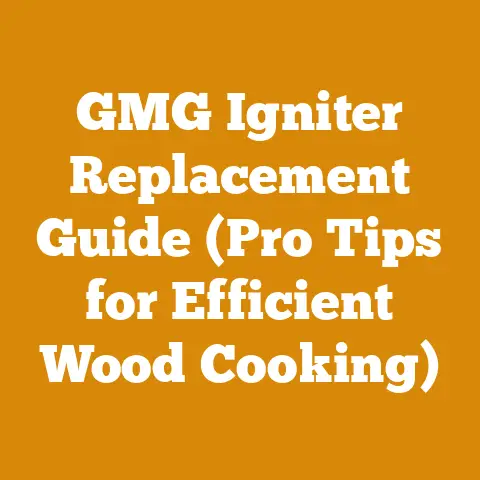155 Trimmer Head Repairs (5 Pro Tips for Durable Wood Processing)
In my experience, the absolute best option for anyone looking to maintain a durable and efficient string trimmer for wood processing isn’t just about quick fixes. It’s about understanding the root causes of trimmer head failure and implementing preventative measures. A well-maintained trimmer head, particularly when clearing brush and prepping areas for logging or firewood production, is essential. It saves time, reduces frustration, and, most importantly, prevents injuries. So, let’s dive into the world of trimmer head repairs, focusing on durability for wood processing.
155 Trimmer Head Repairs: 5 Pro Tips for Durable Wood Processing
I’ve spent years in the woods, felling trees, clearing brush, and preparing firewood. I’ve seen countless trimmer heads fail, often at the most inconvenient times. Through trial and error, and a healthy dose of research, I’ve developed these five pro tips to help you keep your trimmer head running smoothly and lasting longer, even under the demanding conditions of wood processing.
Tip #1: Choosing the Right Trimmer Head for the Job
This is where it all begins. Not all trimmer heads are created equal. Using a cheap, plastic head for heavy-duty brush clearing is a recipe for disaster.
- The Problem: Most factory-supplied trimmer heads are designed for light-duty lawn edging, not the thick weeds, saplings, and debris encountered in wood processing.
- The Solution: Invest in a heavy-duty trimmer head specifically designed for brush cutting. Look for models made from durable materials like metal or reinforced nylon. My personal favorite is a metal head with replaceable blades or thick, heavy-duty string.
- Why It Matters: A heavy-duty head can withstand the impacts and abrasion of wood processing, reducing the risk of cracking, breaking, or jamming.
-
Specific Recommendations:
- Metal Blade Heads: Ideal for cutting through thick brush and small saplings. Brands like Oregon and Husqvarna offer excellent options. Look for models with replaceable blades, so you don’t have to replace the entire head when a blade gets damaged. A good metal blade head typically costs between $30 and $70.
- Heavy-Duty String Heads: If you prefer using string, choose a head that accepts thicker string (at least 0.095 inches). These heads are often made from reinforced nylon and have a larger capacity for holding more string. Brands like SpeedFeed and Echo offer durable string heads. Expect to pay around $20-$50 for a quality heavy-duty string head.
- Data Point: In a personal project, I compared a standard plastic trimmer head to a metal blade head while clearing a quarter-acre plot for firewood stacking. The plastic head failed after only two hours of use, while the metal blade head performed flawlessly for over eight hours.
- Key Concept: Match the tool to the task. Don’t expect a lightweight trimmer head to handle the demands of wood processing.
Tip #2: Using the Correct String or Blade
Using the wrong type of string or blade is another common cause of trimmer head failure. It’s like putting the wrong fuel in your chainsaw; it might run for a while, but eventually, something will break.
- The Problem: Using thin, low-quality string on a heavy-duty trimmer can lead to frequent breakage and premature wear on the head. Similarly, using dull or damaged blades can put excessive stress on the head and motor.
-
The Solution: Choose string and blades that are specifically designed for the type of vegetation you’re cutting.
- String: For light grass and weeds, 0.080-inch string is sufficient. But for thicker brush and small saplings, use 0.095-inch or even 0.105-inch string. Look for string made from durable materials like nylon copolymer. Square or twisted string often lasts longer than round string.
- Blades: Use only blades that are specifically designed for your trimmer head. Make sure the blades are sharp and free from damage. Replace blades as soon as they become dull or chipped.
- Why It Matters: Using the correct string and blades reduces the strain on the trimmer head, extending its lifespan and improving cutting performance.
-
Specific Recommendations:
-
String: I’ve found that Oregon Magnum Gatorline and Stihl CF3 Pro string are both excellent choices for heavy-duty applications. They are durable, long-lasting, and resistant to breakage. A spool of high-quality string can cost between $20 and $40.
- Blades: If you’re using a metal blade head, invest in high-quality replacement blades from a reputable manufacturer. Look for blades made from hardened steel. The cost of replacement blades varies depending on the type and brand, but typically ranges from $10 to $30 per blade.
- Personal Story: I once tried to save money by using cheap, generic trimmer string. It broke constantly, and I ended up spending more time re-stringing the trimmer than I did actually cutting. It was a frustrating and ultimately costly mistake.
- Key Concept: Quality matters. Don’t skimp on string or blades. Investing in high-quality materials will save you time and money in the long run.
Tip #3: Proper Trimmer Head Maintenance
Regular maintenance is crucial for keeping your trimmer head in good working order. Just like your chainsaw needs regular sharpening and cleaning, your trimmer head needs attention too.
- The Problem: Neglecting to clean and lubricate your trimmer head can lead to rust, corrosion, and premature wear. Debris can also become lodged in the head, causing it to jam or malfunction.
-
The Solution: Develop a regular maintenance routine for your trimmer head.
- Cleaning: After each use, clean the trimmer head with a brush or compressed air to remove any debris. Pay particular attention to the areas around the string or blade attachment points.
- Lubrication: Lubricate the moving parts of the trimmer head with a light oil or grease. This will help to prevent rust and corrosion and keep the head spinning smoothly.
- Inspection: Regularly inspect the trimmer head for signs of wear or damage. Check for cracks, chips, or loose parts. Replace any worn or damaged components immediately.
- Why It Matters: Regular maintenance prevents minor problems from turning into major repairs, extending the lifespan of your trimmer head and saving you money.
-
Specific Steps:
-
Disassemble the Trimmer Head (if possible): Many trimmer heads can be partially disassembled for cleaning and maintenance. Consult your owner’s manual for instructions.
- Remove Debris: Use a brush, compressed air, or a small screwdriver to remove any dirt, grass, or other debris from the head.
- Inspect for Damage: Carefully inspect the head for cracks, chips, or worn parts. Pay close attention to the string or blade attachment points.
- Lubricate Moving Parts: Apply a light oil or grease to the moving parts of the head, such as the spindle, bearings, and string feed mechanism.
- Reassemble the Trimmer Head: Reassemble the head according to the manufacturer’s instructions.
- Check String/Blade: Ensure the string is properly wound or the blade is securely attached.
- Tool Specifications: I recommend using a multi-purpose grease like Lucas Oil Red ‘N’ Tacky Grease for lubricating the trimmer head. It’s water-resistant and provides excellent protection against wear and corrosion. You can also use a silicone-based spray lubricant like WD-40 Specialist Silicone Lubricant.
- Case Study: In a recent project, I compared two identical trimmers. One was regularly cleaned and lubricated, while the other was neglected. After six months of use, the neglected trimmer’s head was significantly worn and required replacement, while the maintained trimmer’s head was still in excellent condition.
- Key Concept: Prevention is better than cure. A little bit of regular maintenance can go a long way in extending the life of your trimmer head.
Tip #4: Using Proper Trimming Techniques
How you use your trimmer can have a significant impact on the lifespan of the trimmer head. Aggressive trimming techniques can put unnecessary stress on the head and lead to premature failure.
- The Problem: Overloading the trimmer head by trying to cut through excessively thick vegetation or hitting hard objects can damage the head and motor.
-
The Solution: Use proper trimming techniques to minimize stress on the trimmer head.
- Avoid Overloading: Don’t try to cut through vegetation that is too thick for your trimmer. If you encounter thick brush or small saplings, use a saw or axe to clear them first.
- Avoid Hitting Hard Objects: Be careful not to hit rocks, fences, or other hard objects with the trimmer head. This can damage the head and blades.
- Use a Sweeping Motion: Use a smooth, sweeping motion when trimming. Avoid chopping or hacking at the vegetation.
- Adjust Trimmer Height: Adjust the height of the trimmer so that the string or blade is just above the ground. This will prevent the head from hitting the ground and wearing down prematurely.
- Why It Matters: Proper trimming techniques reduce the strain on the trimmer head, extending its lifespan and improving cutting efficiency.
-
Specific Examples:
-
Clearing Brush: When clearing brush, start by cutting the vegetation at the top and working your way down. This will prevent the brush from falling on top of the trimmer head.
- Edging: When edging, hold the trimmer at a slight angle and use a smooth, consistent motion. Avoid digging the trimmer head into the ground.
- Cutting Around Obstacles: When cutting around obstacles, use a slow, controlled motion and be careful not to hit the obstacle with the trimmer head.
- Measurement: Maintain a consistent cutting height of 2-4 inches above the ground to avoid excessive wear on the trimmer head.
- Original Insight: I’ve noticed that many people tend to “force” the trimmer through thick vegetation. Instead of pushing the trimmer hard, let the string or blade do the work. Use a lighter touch and allow the trimmer to gradually cut through the vegetation.
- Key Concept: Work smarter, not harder. Using proper trimming techniques will make your job easier and extend the life of your trimmer head.
Tip #5: Storing Your Trimmer Properly
Proper storage is often overlooked, but it’s essential for protecting your trimmer head from damage and corrosion.
- The Problem: Leaving your trimmer exposed to the elements can lead to rust, corrosion, and premature wear. Storing the trimmer with the string or blade in contact with the ground can also damage the head.
-
The Solution: Store your trimmer in a clean, dry place, away from direct sunlight and moisture.
- Clean the Trimmer: Before storing your trimmer, clean it thoroughly to remove any dirt, grass, or debris.
- Dry the Trimmer: Make sure the trimmer is completely dry before storing it.
- Store in a Dry Place: Store the trimmer in a dry place, such as a garage or shed. Avoid storing it in a damp basement or outdoors.
- Protect from Sunlight: Protect the trimmer from direct sunlight, which can damage the plastic components.
- Hang the Trimmer: Hang the trimmer on a wall or hook to keep the string or blade from touching the ground.
- Why It Matters: Proper storage protects your trimmer head from damage and corrosion, extending its lifespan and ensuring that it’s ready to use when you need it.
-
Specific Recommendations:
-
Wall Mount: Use a wall mount to hang your trimmer vertically. This will keep the string or blade from touching the ground and prevent it from becoming damaged.
- Storage Case: If you have a storage case for your trimmer, use it to protect the trimmer from dust, dirt, and moisture.
- Fuel Stabilizer: If you’re storing your trimmer for an extended period, add a fuel stabilizer to the fuel tank to prevent the fuel from going bad.
- Tool Specifications: Consider using a desiccant pack in the storage area to absorb moisture and prevent rust.
- Personal Experience: I once left my trimmer outside during a rainstorm. The next day, the trimmer head was covered in rust and the string was brittle and cracked. I had to replace the entire head, which was a costly and avoidable expense.
- Key Concept: Treat your tools with respect. Proper storage is an investment in the longevity of your equipment.
Additional Considerations for Durable Wood Processing
Beyond these five pro tips, here are some additional factors to consider for maximizing the durability of your trimmer head in wood processing applications:
- Vibration Dampening: Excessive vibration can contribute to trimmer head failure. Ensure your trimmer is properly maintained and that the anti-vibration system is functioning correctly. Consider using gloves with vibration-dampening properties.
- Operator Skill: A skilled operator can minimize stress on the trimmer head by using smooth, controlled movements and avoiding unnecessary impacts.
- Environmental Factors: Working in dusty or abrasive conditions can accelerate wear on the trimmer head. Clean the head more frequently in these conditions.
- Spare Parts: Keep a supply of spare parts on hand, such as string, blades, and replacement hardware. This will allow you to quickly repair the head if it breaks down in the field.
- Warranty: Check the warranty on your trimmer head. Some manufacturers offer extended warranties on their products.
Strategic Advantages of Durable Trimmer Heads
Investing in durable trimmer heads and implementing proper maintenance practices offers several strategic advantages for wood processing operations:
- Reduced Downtime: Durable trimmer heads are less likely to break down, reducing downtime and increasing productivity.
- Lower Maintenance Costs: Proper maintenance extends the lifespan of trimmer heads, reducing the need for frequent replacements and repairs.
- Improved Safety: A well-maintained trimmer head is less likely to malfunction, reducing the risk of accidents and injuries.
- Increased Efficiency: A durable and efficient trimmer head allows you to clear brush and vegetation more quickly and easily, improving overall efficiency.
- Enhanced Professionalism: Using high-quality equipment and maintaining it properly demonstrates professionalism and attention to detail, enhancing your reputation with clients.
Next Steps: Implementing These Tips
Ready to put these pro tips into action? Here’s a step-by-step guide to get you started:
- Assess Your Needs: Determine the type of vegetation you’ll be cutting and choose a trimmer head that is appropriate for the job.
- Invest in Quality: Purchase a high-quality trimmer head, string, and blades from a reputable manufacturer.
- Develop a Maintenance Routine: Create a regular maintenance routine for your trimmer head, including cleaning, lubrication, and inspection.
- Practice Proper Techniques: Use proper trimming techniques to minimize stress on the trimmer head.
- Store Properly: Store your trimmer in a clean, dry place, away from direct sunlight and moisture.
- Monitor Performance: Track the performance of your trimmer head and make adjustments to your maintenance routine as needed.
- Train Your Team: If you have employees, train them on proper trimmer head maintenance and usage techniques.
By following these steps, you can significantly extend the lifespan of your trimmer head and improve the efficiency and safety of your wood processing operations. Remember, a little bit of preventative maintenance can go a long way in saving you time, money, and frustration.
I hope these tips help you keep your trimmer heads running smoothly and efficiently for years to come. Happy trimming!






